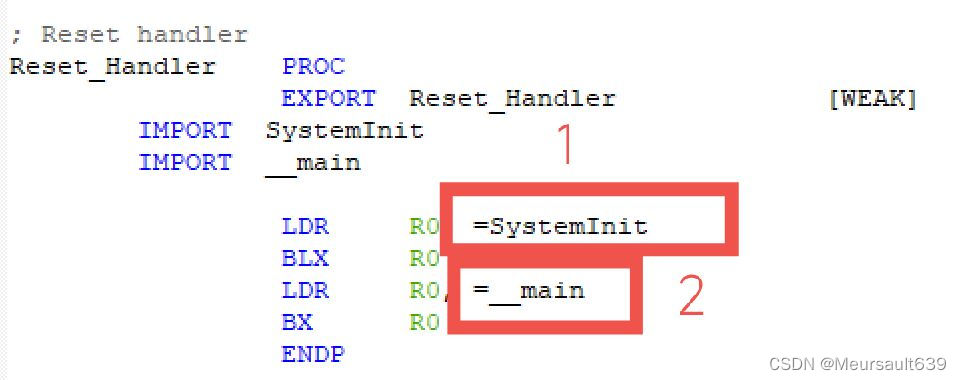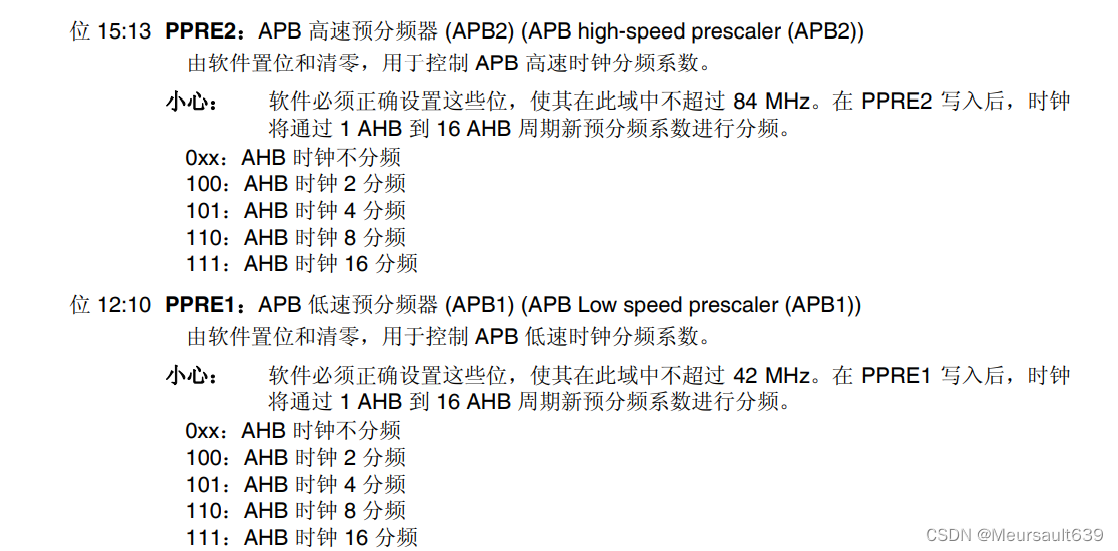首先,我们需要了解一个东西,就是Systemlnit初始化函数会在main函数调用之前被执行,可以简单理解为,Systemlnit初始化函数在启动程序时在main函数之前,如下图所示:
(除此之外,本章还需要之前时钟树的基础,不清楚的可以去上篇文章看看)

接下来我们就正式开始介绍Systemlnit初始化函数了,先上代码,我们后面来慢慢讲解这个函数:
void SystemInit(void)
{
/* FPU settings 浮点运算的配置,此处不讲解------------------------------------------------------------*/
#if (__FPU_PRESENT == 1) && (__FPU_USED == 1)
SCB->CPACR |= ((3UL << 10*2)|(3UL << 11*2)); /* set CP10 and CP11 Full Access */
#endif
/* Reset the RCC clock configuration to the default reset state ------------*/
/* Set HSION bit */
RCC->CR |= (uint32_t)0x00000001;
/* Reset CFGR register */
RCC->CFGR = 0x00000000;
/* Reset HSEON, CSSON and PLLON bits */
RCC->CR &= (uint32_t)0xFEF6FFFF;
/* Reset PLLCFGR register */
RCC->PLLCFGR = 0x24003010;
/* Reset HSEBYP bit */
RCC->CR &= (uint32_t)0xFFFBFFFF;
/* Disable all interrupts */
RCC->CIR = 0x00000000;
#if defined (DATA_IN_ExtSRAM) || defined (DATA_IN_ExtSDRAM)
SystemInit_ExtMemCtl();
#endif /* DATA_IN_ExtSRAM || DATA_IN_ExtSDRAM */
/* Configure the System clock source, PLL Multiplier and Divider factors,
AHB/APBx prescalers and Flash settings ----------------------------------*/
SetSysClock();
/* Configure the Vector Table location add offset address ------------------*/
#ifdef VECT_TAB_SRAM
SCB->VTOR = SRAM_BASE | VECT_TAB_OFFSET; /* Vector Table Relocation in Internal SRAM */
#else
SCB->VTOR = FLASH_BASE | VECT_TAB_OFFSET; /* Vector Table Relocation in Internal FLASH */
#endif
}我们是一行一行代码详细的讲解,不过只要理解了第一行代码,后面的都是类似的,所以我们现在来讲解第一行代码:
// 第一行代码
/* Set HSION bit (打开HSI)*/
RCC->CR |= (uint32_t)0x00000001;对于这样的代码,我们首先要去RCC_CR 寄存器查看一下相应的引脚,因为这是操控了RCC_CR 寄存器的第0位,我们就去看看这一位的含义吧!
所以我们能清楚的看到,这一行代码作用就是打开了HSI(不懂的可以康康上篇文章)。
/* Reset CFGR register */
RCC->CFGR = 0x00000000;
/* Reset HSEON, CSSON and PLLON bits */
RCC->CR &= (uint32_t)0xFEF6FFFF;
/* Reset PLLCFGR register */
RCC->PLLCFGR = 0x24003010;
/* Reset HSEBYP bit */
RCC->CR &= (uint32_t)0xFFFBFFFF;这几行代码作用都是类似的,都是关闭某个引脚,我们举一个例子(第二个)来讲解,后面的都是一样的。 首先 0xFEF6FFFF = 1111 1110 1111 0110 1111 1111 1111 1111 。相当于把第16位和19、24位设置为0。
所以就是关闭了HSE和CSS(用来保障系统时钟,当HSE出了问题的时候,就会由CSS切换到HSI),以及主PLL。
/* Configure the System clock source, PLL Multiplier and Divider factors,
AHB/APBx prescalers and Flash settings ----------------------------------*/
SetSysClock();SetSysClock()函数是特别重要的函数,接下来我们会来详细讲解一下,也是会一行一行进行讲解,先上代码:
static void SetSysClock(void)
{
#if defined (STM32F40_41xxx) || defined (STM32F427_437xx) || defined (STM32F429_439xx) || defined (STM32F401xx)
/******************************************************************************/
/* PLL (clocked by HSE) used as System clock source */
/******************************************************************************/
__IO uint32_t StartUpCounter = 0, HSEStatus = 0;
/* Enable HSE */
RCC->CR |= ((uint32_t)RCC_CR_HSEON);
/* Wait till HSE is ready and if Time out is reached exit */
do
{
HSEStatus = RCC->CR & RCC_CR_HSERDY;
StartUpCounter++;
} while((HSEStatus == 0) && (StartUpCounter != HSE_STARTUP_TIMEOUT));
if ((RCC->CR & RCC_CR_HSERDY) != RESET)
{
HSEStatus = (uint32_t)0x01;
}
else
{
HSEStatus = (uint32_t)0x00;
}
if (HSEStatus == (uint32_t)0x01)
{
/* Select regulator voltage output Scale 1 mode */
RCC->APB1ENR |= RCC_APB1ENR_PWREN;
PWR->CR |= PWR_CR_VOS;
/* HCLK = SYSCLK / 1*/
RCC->CFGR |= RCC_CFGR_HPRE_DIV1;
#if defined (STM32F40_41xxx) || defined (STM32F427_437xx) || defined (STM32F429_439xx)
/* PCLK2 = HCLK / 2*/
RCC->CFGR |= RCC_CFGR_PPRE2_DIV2;
/* PCLK1 = HCLK / 4*/
RCC->CFGR |= RCC_CFGR_PPRE1_DIV4;
#endif /* STM32F40_41xxx || STM32F427_437x || STM32F429_439xx */
#if defined (STM32F401xx)
/* PCLK2 = HCLK / 2*/
RCC->CFGR |= RCC_CFGR_PPRE2_DIV1;
/* PCLK1 = HCLK / 4*/
RCC->CFGR |= RCC_CFGR_PPRE1_DIV2;
#endif /* STM32F401xx */
/* Configure the main PLL */
RCC->PLLCFGR = PLL_M | (PLL_N << 6) | (((PLL_P >> 1) -1) << 16) |
(RCC_PLLCFGR_PLLSRC_HSE) | (PLL_Q << 24);
/* Enable the main PLL */
RCC->CR |= RCC_CR_PLLON;
/* Wait till the main PLL is ready */
while((RCC->CR & RCC_CR_PLLRDY) == 0)
{
}
#if defined (STM32F427_437xx) || defined (STM32F429_439xx)
/* Enable the Over-drive to extend the clock frequency to 180 Mhz */
PWR->CR |= PWR_CR_ODEN;
while((PWR->CSR & PWR_CSR_ODRDY) == 0)
{
}
PWR->CR |= PWR_CR_ODSWEN;
while((PWR->CSR & PWR_CSR_ODSWRDY) == 0)
{
}
/* Configure Flash prefetch, Instruction cache, Data cache and wait state */
FLASH->ACR = FLASH_ACR_PRFTEN | FLASH_ACR_ICEN |FLASH_ACR_DCEN |FLASH_ACR_LATENCY_5WS;
#endif /* STM32F427_437x || STM32F429_439xx */
#if defined (STM32F40_41xxx)
/* Configure Flash prefetch, Instruction cache, Data cache and wait state */
FLASH->ACR = FLASH_ACR_PRFTEN | FLASH_ACR_ICEN |FLASH_ACR_DCEN |FLASH_ACR_LATENCY_5WS;
#endif /* STM32F40_41xxx */
#if defined (STM32F401xx)
/* Configure Flash prefetch, Instruction cache, Data cache and wait state */
FLASH->ACR = FLASH_ACR_PRFTEN | FLASH_ACR_ICEN |FLASH_ACR_DCEN |FLASH_ACR_LATENCY_2WS;
#endif /* STM32F401xx */
/* Select the main PLL as system clock source */
RCC->CFGR &= (uint32_t)((uint32_t)~(RCC_CFGR_SW));
RCC->CFGR |= RCC_CFGR_SW_PLL;
/* Wait till the main PLL is used as system clock source */
while ((RCC->CFGR & (uint32_t)RCC_CFGR_SWS ) != RCC_CFGR_SWS_PLL);
{
}
}
else
{ /* If HSE fails to start-up, the application will have wrong clock
configuration. User can add here some code to deal with this error */
}
#elif defined (STM32F411xE)
#if defined (USE_HSE_BYPASS) 现在要介绍SetSysClock函数,首先,我们要清楚一个知识点,就是使能时钟之后,需要等待一段时间才能使用。其次,因为我使用的是F407系列的开发板,所以就只介绍407系列的部分。
/* Enable HSE */
RCC->CR |= ((uint32_t)RCC_CR_HSEON);
// 宏定义
#define RCC_CR_HSEON ((uint32_t)0x00010000)这个其实就是我们之前介绍的代码,只不过使用了宏定义,我把宏定义也贴出来。
0x00010000 = 0000 0000 0000 0001 0000 0000 0000 0000,也就是使能了第16位。
/* Wait till HSE is ready and if Time out is reached exit */
do
{
HSEStatus = RCC->CR & RCC_CR_HSERDY;
StartUpCounter++;
} while((HSEStatus == 0) && (StartUpCounter != HSE_STARTUP_TIMEOUT));
if ((RCC->CR & RCC_CR_HSERDY) != RESET)// RESET为0
{
HSEStatus = (uint32_t)0x01;
}
else
{
HSEStatus = (uint32_t)0x00;
}
#define RCC_CR_HSERDY ((uint32_t)0x00020000)这个就是等待的代码,控制的是第17位,当稳定后,HSEStatus为1。
if (HSEStatus == (uint32_t)0x01)
{
/* Select regulator voltage output Scale 1 mode (这个是电压的代码,暂时不讲解)*/
RCC->APB1ENR |= RCC_APB1ENR_PWREN;
PWR->CR |= PWR_CR_VOS;
/* HCLK = SYSCLK / 1*/
RCC->CFGR |= RCC_CFGR_HPRE_DIV1;
#if defined (STM32F40_41xxx) || defined (STM32F427_437xx) || defined (STM32F429_439xx)
/* PCLK2 = HCLK / 2*/
RCC->CFGR |= RCC_CFGR_PPRE2_DIV2;
/* PCLK1 = HCLK / 4*/
RCC->CFGR |= RCC_CFGR_PPRE1_DIV4;
#endif /* STM32F40_41xxx || STM32F427_437x || STM32F429_439xx */
#if defined (STM32F401xx)
/* PCLK2 = HCLK / 2*/
RCC->CFGR |= RCC_CFGR_PPRE2_DIV1;
/* PCLK1 = HCLK / 4*/
RCC->CFGR |= RCC_CFGR_PPRE1_DIV2;
#endif /* STM32F401xx */
/* Configure the main PLL */
RCC->PLLCFGR = PLL_M | (PLL_N << 6) | (((PLL_P >> 1) -1) << 16) |
(RCC_PLLCFGR_PLLSRC_HSE) | (PLL_Q << 24);
/* Enable the main PLL */
RCC->CR |= RCC_CR_PLLON;
/* Wait till the main PLL is ready */
while((RCC->CR & RCC_CR_PLLRDY) == 0)
{
}这部分是稳定下来后做的事,我们还是来一一讲解。
/* HCLK = SYSCLK / 1*/
RCC->CFGR |= RCC_CFGR_HPRE_DIV1;
#define RCC_CFGR_HPRE_DIV1 ((uint32_t)0x00000000) /*!< SYSCLK not divided */HCLK需要通过AHB分频器(系统时钟部分讲过,看一下时钟树就好了),这样设置,就是选择不分频。
#if defined (STM32F40_41xxx) || defined (STM32F427_437xx) || defined (STM32F429_439xx)
/* PCLK2 = HCLK / 2*/
RCC->CFGR |= RCC_CFGR_PPRE2_DIV2;
/* PCLK1 = HCLK / 4*/
RCC->CFGR |= RCC_CFGR_PPRE1_DIV4;
#endif /* STM32F40_41xxx || STM32F427_437x || STM32F429_439xx */控制的是这两个PCLK,过程一样。
/* Configure the main PLL */
RCC->PLLCFGR = PLL_M | (PLL_N << 6) | (((PLL_P >> 1) -1) << 16) |
(RCC_PLLCFGR_PLLSRC_HSE) | (PLL_Q << 24);
这部分是用来设置PLL频率的,这个是系统启动文件直接设置好了的,如下所示,就不需要我们去管了,出来就直接是168MHz。
#if defined (STM32F40_41xxx) || defined (STM32F427_437xx) || defined (STM32F429_439xx) || defined (STM32F401xx) /* PLL_VCO = (HSE_VALUE or HSI_VALUE / PLL_M) * PLL_N */ #define PLL_M 8 #else /* STM32F411xE */ #if defined (USE_HSE_BYPASS) #define PLL_M 8 #else /* STM32F411xE */ #define PLL_M 16 #endif /* USE_HSE_BYPASS */ #endif /* STM32F40_41xxx || STM32F427_437xx || STM32F429_439xx || STM32F401xx */ /* USB OTG FS, SDIO and RNG Clock = PLL_VCO / PLLQ */ #define PLL_Q 7 #if defined (STM32F40_41xxx) #define PLL_N 336 /* SYSCLK = PLL_VCO / PLL_P */ #define PLL_P 2 #endif /* STM32F40_41xxx */ #if defined (STM32F427_437xx) || defined (STM32F429_439xx) #define PLL_N 360 /* SYSCLK = PLL_VCO / PLL_P */ #define PLL_P 2 #endif /* STM32F427_437x || STM32F429_439xx */
/* Enable the main PLL */
RCC->CR |= RCC_CR_PLLON;
/* Wait till the main PLL is ready */
while((RCC->CR & RCC_CR_PLLRDY) == 0)
{
}打开主PLL,和等待,现在应该不难理解了。
/* Select the main PLL as system clock source */
RCC->CFGR &= (uint32_t)((uint32_t)~(RCC_CFGR_SW));
RCC->CFGR |= RCC_CFGR_SW_PLL;
#define RCC_CFGR_SW_PLL ((uint32_t)0x00000002) /*!< PLL selected as system clock */这是最后一步,选择主PLL为时钟源。
总结: Systemlnit初始化函数做的事情如下所示:
- 关闭所有的引脚
- 打开HSE
- 打开AHB以及HCLK
- 配置好PLL
- 选择PLL为系统时钟源
好了,Systemlnit初始化函数就介绍到这,希望能对大家有所帮助。





























 581
581











 被折叠的 条评论
为什么被折叠?
被折叠的 条评论
为什么被折叠?








